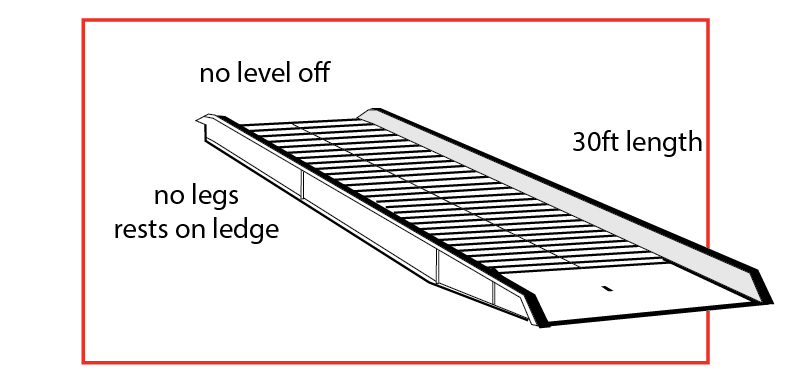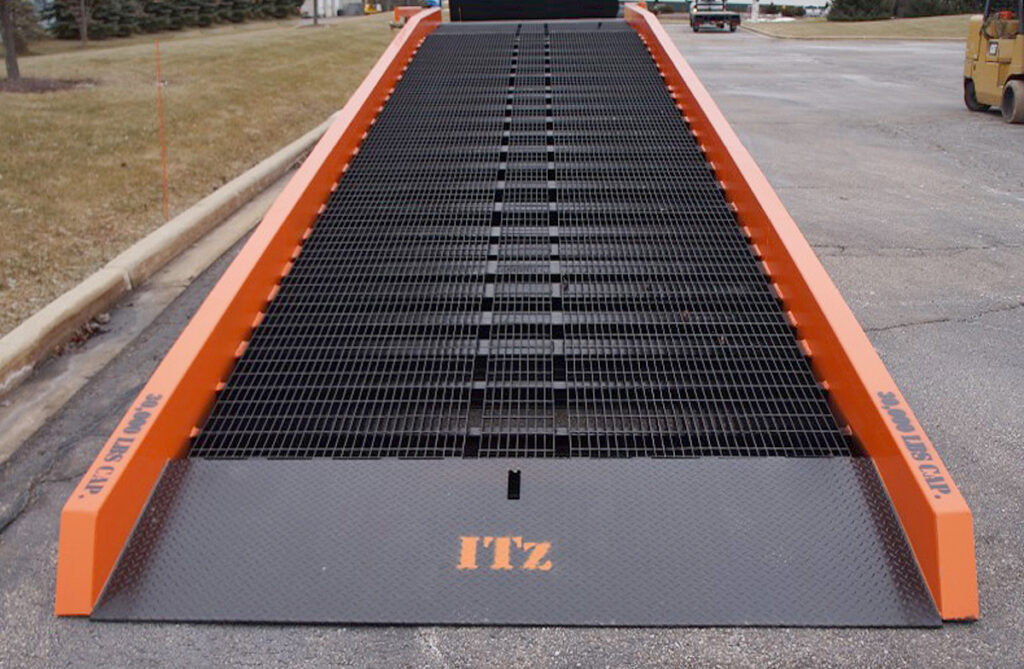Whether you’re looking to streamline your operations, complete a temporary job, or ensure the safety of your staff, choosing the right type of equipment is crucial. When loading and unloading large payloads and equipment, you need a ground-to-dock or ground-to-trailer ramp, also known as a yard ramp. But what kind of yard ramp should you purchase? When you first begin your search, you may not realize that there are different types of yard ramps. Although they seem similar, the distinctions between them can significantly impact their application and effectiveness in different scenarios.
In this blog, we’ll explore the key differences between stationary yard-to-dock ramps and portable yard ramps, helping you decide which one is the best fit for your business.
Yard-to-Dock Ramps (AKA Stationary Yard Ramps)
A yard-to-dock ramp is a type of ramp designed to bridge the gap between the ground level and a loading dock. These ramps are built to be robust to transport heavy equipment and cargo and are typically more permanent or semi-permanent fixtures.
Portable Loading Dock (AKA Portable Yard Ramps)
Portable loading dock ramps, on the other hand, offer flexibility and mobility, making them suitable for various temporary or transitional loading needs. These ramps are designed to be easily moved and adjusted to different locations as required.
Key Differences
When it comes to choosing the right ramp solution for your business, it’s essential to understand the key differences between yard-to-dock (stationary) ramps and portable yard ramps. Each type offers features and benefits that can impact your operations and efficiency. In this section, we’ll explore the distinct characteristics of both ramps, helping you determine which one is the best fit for your specific application.
Stationary vs. Mobile
The primary difference between ground-to-dock ramps and portable loading docks is their mobility. Portable loading docks feature landing gear with wheels and a manual crank to move the ramp up and down. Once it’s delivered, it can be moved around the location with a forklift as needed. Ground-to-dock ramps, on the other hand, do not have wheels, landing gear, or a crank. They simply rest on the edge of the dock.
With or Without Level-off
Another key difference between these two ramps is that stationary ground-to-dock ramps are often constructed without a level-off to create a direct and continuous incline from the ground level to the dock height. This is ideal for consistent operations where heavy loads are transported regularly and the gradient does not change.
On the other hand, portable yard ramps are constructed with a level-off to allow for a smoother transition between varying dock and trailer heights. The level-off feature not only accommodates different types of vehicles but also improves safety by reducing the risk of accidents during loading and unloading. This level-off is especially crucial for loading and unloading trailers, where the forks of a forklift must be horizontal to the load deck or floor in order to lift pallets.
Flexibility
While ground-to-dock ramps are designed to be installed and used semi-permanently at one dock location, portable loading docks can be moved and used at multiple docks, as well as with trailers, railcars, or other locations. The landing gear and manual crank allow portable loading docks to accommodate a variety of heights. They’re also able to be maneuvered around a loading location with just a forklift.
Installation
Because ground-to-dock ramps are meant to be stationary, resting on a permanent dock surface, they require a different installation than portable yard ramps. Once your stationary ground-to-dock ramp is delivered, you’ll need to secure it to the loading dock by either spot welding it or using a mounting bracket or anchor bolts. On the other hand, portable loading docks are ready to be used with a dock or trailer as soon as they are delivered. Their landing gear keeps them securely in place, with additional safety chains for added security.

When You Should Use a Yard-to-Dock Ramp
In general, stationary ground-to-dock ramps are ideal when your business requires a reliable, long-term solution for high-volume and consistent loading and unloading operations. These ramps are ideal for environments such as warehouses, distribution centers, manufacturing plants, and industrial facilities where stability, safety, and durability are crucial. They are specifically designed for use on loading docks, where they can rest on the lip of the dock and do not require a level-off.
In summary, yard-to-dock ramps are best for applications where:
- The ramp is only needed on one dock.
- You plan to use the ramp consistently in one spot.
- You are looking for a semi-permanent solution.

When a Portable Loading Dock is the Ideal Solution
Portable loading docks or yard ramps are best suited for applications that require flexibility, mobility, and adaptability in their loading and unloading operations. These ramps are ideal for environments where multiple loading docks are needed or where there is no permanent loading dock available. They are especially beneficial for businesses that handle variable load sizes, different vehicle types, or frequently change locations, such as construction sites, rental facilities, or logistics operations with varying delivery points. Portable ramps offer a quick and efficient solution to connect trailers and trucks to warehouses or ground levels without the need for permanent infrastructure. Their ease of movement makes them a perfect choice for temporary needs, seasonal operations, or environments where space is limited and quick setup is essential. With the ability to adjust to different heights and inclines, portable loading dock ramps provide the versatility necessary for dynamic business operations.
In summary, portable loading docks are best for applications where:
- It is a dynamic environment where the ramp will be used in multiple places.
- The ramp will be used at a dock OR a trailer or railcar.
- You are looking for a semi-permanent or temporary solution.
- You only need the ramp on a month-to-month basis for particular jobs.
- The ramp will be used in places of differing heights.
The Ideal Yard Ramp for Your Business
Choosing between a yard-to-dock ramp and a portable loading dock ramp depends on the specific needs of your operation. Yard-to-dock ramps provide a robust, permanent solution for fixed dock locations, ensuring stability and durability for heavy-duty use. On the other hand, portable loading dock ramps offer unparalleled flexibility and mobility, making them suitable for varied and temporary loading requirements. Understanding these differences will help you select the right ramp to optimize your material handling processes and enhance operational efficiency.
Give us a call at 262-671-5000 and one of our ramp experts can answer any questions you may have about selecting the best portable loading dock. We can also provide you with a free quote!
